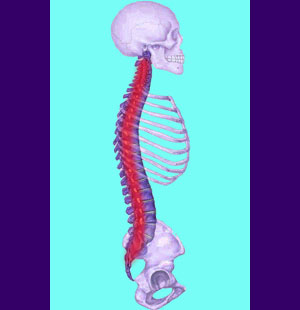
Spine pain describes symptoms that originate in the actual vertebral column, as opposed to the surrounding musculature or other nearby anatomical locales. True spinal discomfort can be neurological or mechanical in nature. It must immediately be noted that spinal symptoms are often misdiagnosed as coming from the structures in the backbone, when all along the pain is actually being generated by the back muscles and other soft tissues which surround the spine. In just as many cases, pain might be completely nonstructural, being generated by the interactions of the mind and body and are merely being expressed in the dorsal anatomy.
The spinal structures are typically implicated in causing a variety of symptomatic presentations, including chronic back pain, tingling, weakness and numbness, and in some cases, these diagnostic theories are correct. However, in many cases, the symptoms are too wide spread, diversified or variable to come from a particular vertebral or intervertebral segment. In most of these cases, the actual source of pain comes from the muscular structures in the back or from the mindbody processes.
This dialog examines the actual occurrence of spinally-induced pain, as well as the common mistaken implication of spinal abnormalities as the suspected causation of suffering.
Spine Pain Versus Back Pain
The back is the total of the spine and all the other tissues which are present in the dorsal section of the anatomy. The spine is comprised of vertebral bones, intervertebral discs, ligaments, neurological tissue and other structures. Meanwhile, the back muscles are a complex and woven network of tissues which surround and support the skeletal spine. All of these tissues interact with the mind’s organ, the brain, to receive their instructions on proper functionality.
Spinal pain denotes symptoms that originate in the vertebral column itself and are expressed within the backbone or in areas of the body served by spinal nerves.
Muscular back pain might surround the spine and seem to come from within, but actually originates in the supportive soft tissues outside the spinal anatomy.
Mindbody pain, also known as TMS or psychogenic pain, might be located in the spine or within the muscular support system, but actually originates in the mind.
Idiopathic back pain is exponentially more prevalent than proven and verified spinal pain. The key distinction is that idiopathic back pain may or may not involve the vertebral structures, while spinal discomfort certainly does involve a spinal origin of symptomatic expression.
Spinal Pain Treatment
For truly symptomatic spinal abnormalities, conservative care is usually advised unless the treatment presents a medical emergency, such as in the dire example of cauda equina syndrome.
Structural conditions which are painful may resolve with time and noninvasive care, as long as the diagnosis is correct. Some spinal conditions may require more drastic therapies, including back surgery interventions in extreme cases.
Back pain which exists in the muscles rarely responds well to any type of treatment. The usual diagnoses relating to chronic muscular pain include piriformis syndrome, thoracic outlet syndrome, fibromyalgia and other soft tissue verdicts, such as functional short leg syndrome and muscle imbalances.
Symptomatic care usually provides partial temporary relief, while surgery may provide a real cure or might fail miserably.
Mindbody variants of spine pain and back pain will not respond well to any type of physical treatment, be it surgical or conservative, except by temporary placebo effect. However, most mindbody concerns can be resolved with a psychological approach to care, including knowledge therapy techniques which allow the patient to understand the underlying causative mechanisms in the brain.
Spine Pain Facts
The spine is far more durable and flexible in its adaptability than most care providers will casually admit to. If you speak to some opportunistic doctors and chiropractors, the spine will be described as an easily-damaged and overly-sensitive structure which can degenerate and breakdown without warning. This idea is illogical and ridiculous.
The spine is the fundamental basis for our success as a species and imparts all the advantages of our human upright posture. The old myths about people being designed to walk on all fours, and this being the explanation for back pain, is simply ludicrous. Evolution over countless millennia has prepared the human spine to do exactly what it has done for countless generations and that is to serve us well over a lifetime of strenuous exertion.
Remember, chronic back pain is a relatively new evolutionary trait demonstrated by humans. These syndromes have little mention in the medical journals of antiquity, which shows that the human spine has somehow suffered complete and utter ruin in the past 70 years or that something is greatly amiss in the diagnostic sector of orthopedic and neurological medicine. maybe the doctors have it all wrong? It would not be the first time, for sure!
In summary, the spine is sometimes to blame for symptoms, but it also should respond well to appropriate treatment. For chronic, unresponsive spine pain concerns, the troublesome issue usually lies in the muscles, or the mind, regardless of whether or not the pain seems to originate in the spine proper.




